Mid-IR gas-sensing applications are currently some of the fastest-growing markets for sensors, driven by social needs for better quality of life, geopolitical situations and recent technological advances such as fast, uncooled detectors, new tunable sources and mid-IR optics. And the need is growing.
ADAM PIOTROWSKI, VIGO SYSTEMS S.A
Demands from industrial, petrochemical and new medical diagnostic applications are very wide-ranging — from air quality, emission monitoring and leak detectors, to breath analyzers and explosive material sensors. For many years, mid-IR components were considered expensive, immature and unreliable for wide application in this range. Swift growth of the mid-IR market1 is changing that.

Uncooled detector chips with a monolithic immersion flip-chip that is mounted to sapphire chip carriers.
More recently, quantum cascade lasers and detectors have become more affordable. Some mid-IR detectors that several years ago were sold above €1000 (about $1090) now cost below €300 (about $327), and with an increase in global sales of such devices, there are possibilities for further cost reduction. Reliability of these components was proven with the tunable laser spectrometer2 aboard NASA’s Curiosity Mars rover and with military applications3.
Most gases (e.g., NOx, SOx, COx and hydrocarbons) can be detected in the 3- to 12-µm range using rotational vibrational absorption. Each of the gases has specific spectral features such as hydrocarbons, lines or broader absorption spectrum. The idea is based on the Beer-Lambert law:
I (λ) = I0 (λ) exp(α(λ) • x)
Light emitted from a source (Table 1) is transmitted through the gas sample and detected by the optimized photodetector. The detected signal is strongly dependent on distance (x) and absorption coefficient (α).
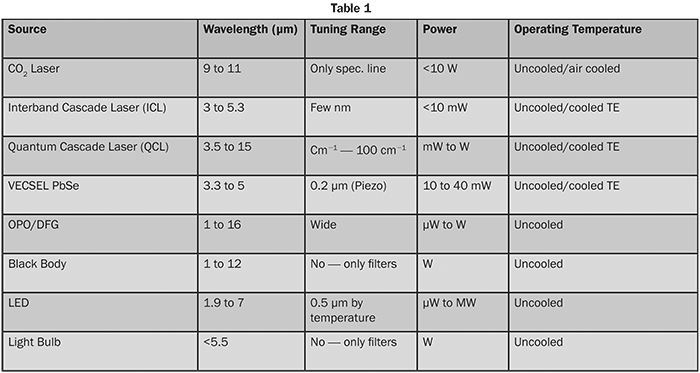
Gases like CO2 have characteristic lines in the near-IR (around 1.55 µm). But typically the absorption in longer wavelengths (i.e., around 4.3 µm) is stronger, and similar attenuation can be detected at shorter distances. Thus, the total size of the sensor can be significantly reduced. This type of setup enables detection of many compounds with detection limits starting from parts per million, down to parts per trillion levels. To achieve selectivity, a thermal source can be used, as well as a detector with a filter. To subtract background and detect different compounds, multiple color detectors are often used. An even better solution is to use tunable sources4 and optimized detectors for the given wavelength range.
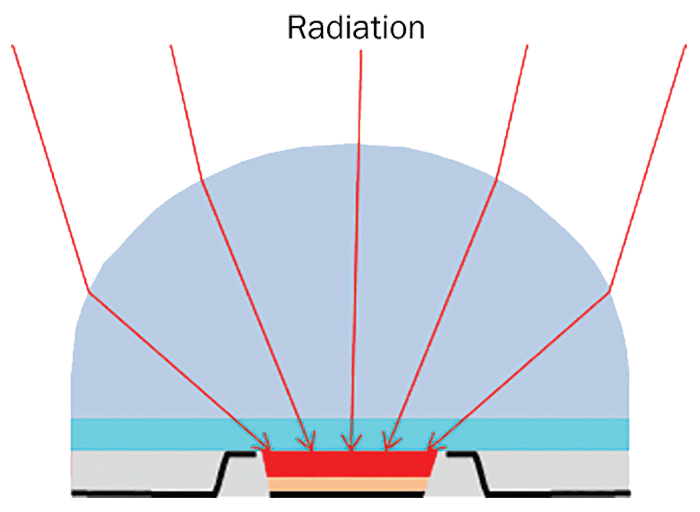
Radiation is an active element with monolithic immersion lenses.
The other option is to mount a Fabry-Perot interferometer on top of the detector and use a thermal source. In both cases, speed and sensitivity of the detector are required. For many years, a major drawback of high-performance detectors was the need for liquid nitrogen cooling. Traditionally, these detectors have been grown by liquid phase epitaxy.
Now, the ultimate goal is to reach background-limited performance (BLIP). To achieve this at high operating temperatures, multiple functions in a single chip — including concentration of the radiation on an optimized absorber, good carrier collection, suppression of thermal generation, minimization of parasitic impedances, shielding against background radiation and heat dissipation — must be integrated.
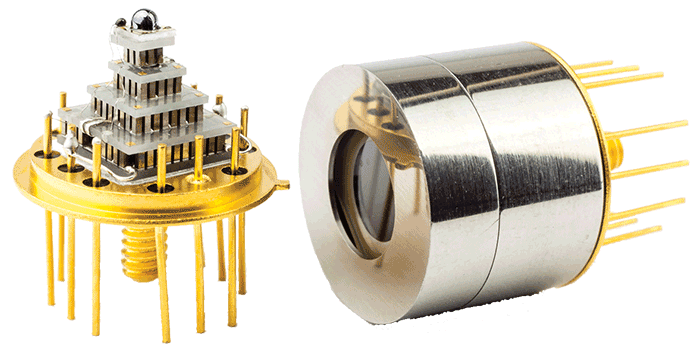
A four-stage Peltier-cooled detector with a monolithic immersion lens.
The present development of high-operating-temperature IR photodetectors has been dominated by complex bandgap heterostructures grown by low-pressure and flexible technologies such as molecular beam epitaxy (MBE) or metalorganic chemical vapor deposition (MOCVD). Among variable bandgap semiconductor alloys, Hg1−xCdxTe is the only material covering the entire IR spectral range having nearly the same lattice parameters. The difference in lattice crystal that is constant between CdTe (Eg = 1.5eV) and Hg0.8Cd0.2Te (Eg = 1.5 eV) is ~2 percent. Technological motivations, namely the instability of the material because of low HgTe bond and use of toxic materials such as mercury or cadmium, have created multiple attempts to replace HgCdTe.
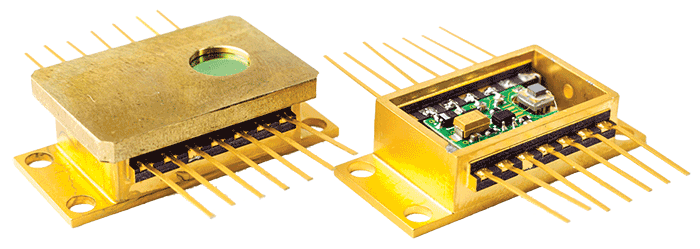
Miniaturized integrated detection modules for fast applications (0.5 to 2 GHz).
Theoretically, the same performance might be reached with Sb-based heterostructures, including InAsSb and type-II superlattice, and might offer significant performance in the whole 3- to 12-µm range. Both HgCdTe- and Sb-based material have lattice-matched substrates CdTe and GaSb. However, for both material groups, buffered GaAs is favorable because of its low cost, high quality and transmission in the whole mid-IR range.
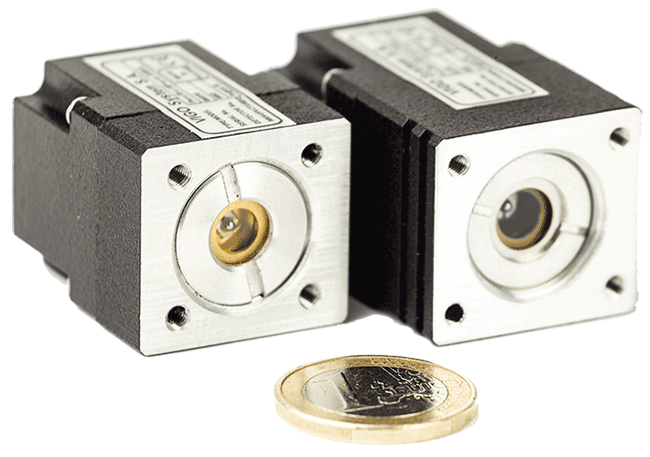
Integrated detection modules for uncooled and Peltier-cooled detectors.
As a result, it is possible to manufacture a unique concentrator directly onto the detector chip — a monolithic immersion lens made out of GaAs used for growth. With fixed optical size, GaAs optical immersion can lead to a 100× decrease of absorber material volume, a 100× increase in speed of response and a 10× increase in detection-normalized signal-to-noise ratio.
Semiconductor heterostructure and device types (Table 2) can be optimized for specific frequency, wavelength range and temperature of operation. Photoconductors can be optimized for broadband operation at intermediate frequencies, while photovoltaic devices can be used for CW operation and higher frequencies. Single-junction photovoltaic devices have optical availability usually limited to 1 × 1 mm. For larger optical areas, PC or multiple-junction photovoltaic detectors are recommended.
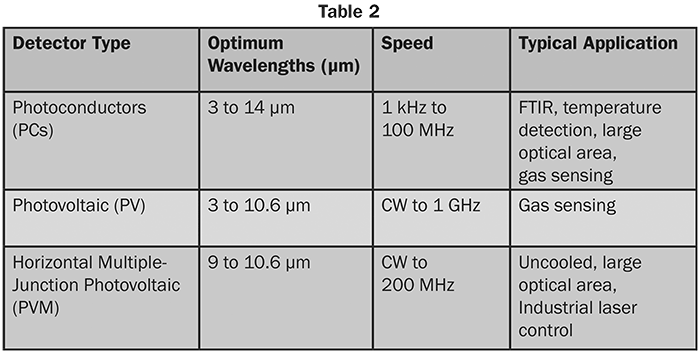
Stability and performance of the detector depend strongly on temperature. Gas-sensing applications are usually related to a wide range of required environmental conditions, needing at least single-stage Peltier coolers to stabilize the temperature even in the range −40 °C to 70 °C. Availability of multistage miniature Peltier coolers where elements are cascaded to achieve higher temperature differences (up to 125 K) made possible affordable IR detectors with ultimate performance and speed of response. To operate in such conditions, hermetization of a detector with IR transparent windows (ZnSe, BaF2 or Si with antireflection coating) is crucial. For best performance, it should be a vacuum package or noble gas back-filled.

Depiction of a typical gas analyzer arrangement.
System development requires a multidisciplinary knowledge on interfaces between each subsystem. Gas analyzer designers should take into account the device’s optics, mechanics, electronics, electromagnetic interferences and thermal transport, among others. Only standardized, flexible integrated detection modules can provide an ultimate solution. Such modules can provide impedance-matched preamplifiers, standard output impedance (i.e., 50 ohm), heat spreading, mechanical interfaces to external optics, or even aligned collection optics and digital output. That implements an Internet-of-Things approach for mid-IR sensors with digitally controlled parameters including gain, temperature or bandwidth.
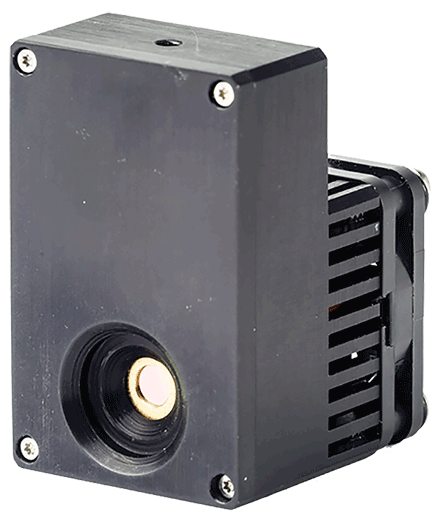
Integrated detection modules with Peltier-cooled controllers.
Working on novel systems such as breath analyzers, handheld emission monitoring systems and leak detectors requires fast response to market demands.
Meet the author
Dr. Adam Piotrowski is president of Vigo Systems S.A. in Poland; email: [email protected].
References
1. Wintergreen Research report (2016). Mid-IR sensors: Market shares, strategies, and forecasts, worldwide, 2016 to 2022.
2. NASA Jet Propulsion Laboratory: https://microdevices.jpl.nasa.gov/capabilities/semiconductor-lasers/tunable-laser-spectrometers.php.
3. T. Day et al. (Oct. 29, 2013). Quantum cascade lasers for defense & security, Proc SPIE, Vol. 8898, 889802; doi:10.1117/12.2031536.
4. P. Fuchs et al. (2010). Widely tunable quantum cascade lasers with coupled cavities for gas detection. Appl Phys Lett Vol. 97, Issue 18.